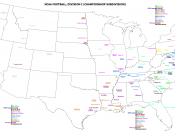Paying College Athletes It is six o'clock in the afternoon at Florida State University. A young college football player has just finished a three-hour practice and is walking down the sidewalk with his teammates. They enter the local McDonald's for a burger. The young football star reaches into his pocket and pulls out a hand full of lint. He cannot work a part-time job like the vast majority of his peers, cause he already has a full time job in football. His coaches, trainers, athletic directors, and the university are all making large amounts of money off him and his teammates. The actual producers of the revenue, the players, cannot afford a burger not to mention the $70 replica jerseys of their self sold in the school bookstore. The National Collegiate Athletic Association (NCAA) has a tight set of rules to maintain players' amateur status that prohibit payments to student athletes, but competing in the NCAA at the Division 1-A level has become a year-round, full-time job for most athletes.
For most collegiate athletes the rigors and demands of a twelve-month dedication to their sport have become facts of life. Last year alone collegiate sports generated over $2 billion among the 114 schools that compete in division 1-A (Christensen, 2000). Although scholarships pay for a college education, many believe that student athletes should receive money that the schools make from athletic programs.
The NCAA has a history of suspending athletes for extra benefits. Roughly 130,000 Division 1 athletes compete in collegiate sports, the NCAA makes money off each athlete (Stewart, 1998). For example, the teams competing in the six major bowl games shared over $40 million that sponsors put up for the games. In the 1995 Fiesta Bowl, both Nebraska and Florida each received $8.6 million for sending their football...


